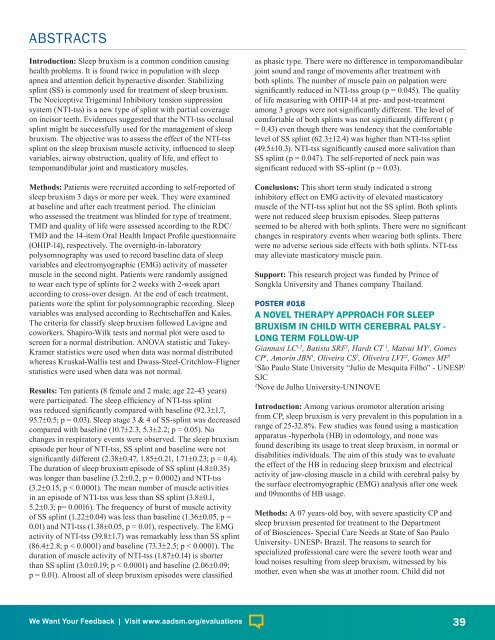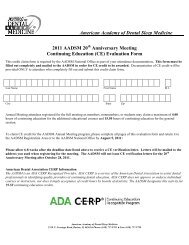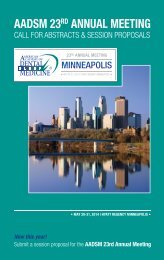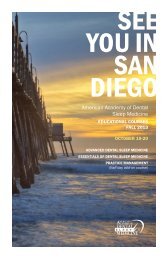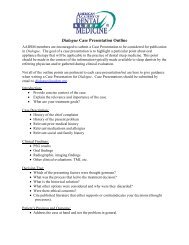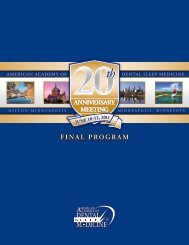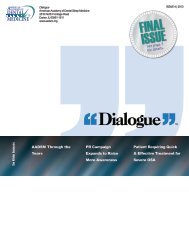Annual Meeting American Academy Of Dental Sleep Medicine
Annual Meeting American Academy Of Dental Sleep Medicine
Annual Meeting American Academy Of Dental Sleep Medicine
Create successful ePaper yourself
Turn your PDF publications into a flip-book with our unique Google optimized e-Paper software.
ABSTRACTSIntroduction: <strong>Sleep</strong> bruxism is a common condition causinghealth problems. It is found twice in population with sleepapnea and attention deficit hyperactive disorder. Stabilizingsplint (SS) is commonly used for treatment of sleep bruxism.The Nociceptive Trigeminal Inhibitory tension suppressionsystem (NTI-tss) is a new type of splint with partial coverageon incisor teeth. Evidences suggested that the NTI-tss occlusalsplint might be successfully used for the management of sleepbruxism. The objective was to assess the effect of the NTI-tsssplint on the sleep bruxism muscle activity, influenced to sleepvariables, airway obstruction, quality of life, and effect totempomandibular joint and masticatory muscles.Methods: Patients were recruited according to self-reported ofsleep bruxism 3 days or more per week. They were examinedat baseline and after each treatment period. The clinicianwho assessed the treatment was blinded for type of treatment.TMD and quality of life were assessed according to the RDC/TMD and the 14-item Oral Health Impact Profile questionnaire(OHIP-14), respectively. The overnight-in-laboratorypolysomnography was used to record baseline data of sleepvariables and electromyographic (EMG) activity of massetermuscle in the second night. Patients were randomly assignedto wear each type of splints for 2 weeks with 2-week apartaccording to cross-over design. At the end of each treatment,patients wore the splint for polysomnographic recording. <strong>Sleep</strong>variables was analysed according to Rechtschaffen and Kales.The criteria for classify sleep bruxism followed Lavigne andcoworkers. Shapiro-Wilk tests and normal plot were used toscreen for a normal distribution. ANOVA statistic and Tukey-Kramer statistics were used when data was normal distributedwhereas Kruskal-Wallis test and Dwass-Steel-Critchlow-Flignerstatistics were used when data was not normal.Results: Ten patients (8 female and 2 male; age 22-43 years)were participated. The sleep efficiency of NTI-tss splintwas reduced significantly compared with baseline (92.3±1.7,95.7±0.5; p = 0.03). <strong>Sleep</strong> stage 3 & 4 of SS-splint was decreasedcompared with baseline (10.7±2.3, 5.3±2.2; p = 0.05). Nochanges in respiratory events were observed. The sleep bruxismepisode per hour of NTI-tss, SS splint and baseline were notsignificantly different (2.38±0.47, 1.85±0.21, 1.71±0.23; p = 0.4).The duration of sleep bruxism episode of SS splint (4.8±0.35)was longer than baseline (3.2±0.2, p = 0.0002) and NTI-tss(3.2±0.15, p < 0.0001). The mean number of muscle activitiesin an episode of NTI-tss was less than SS splint (3.8±0.1,5.2±0.3; p= 0.0016). The frequency of burst of muscle activityof SS splint (1.22±0.04) was less than baseline (1.36±0.05, p =0.01) and NTI-tss (1.38±0.05, p = 0.01), respectively. The EMGactivity of NTI-tss (39.8±1.7) was remarkably less than SS splint(86.4±2.8; p < 0.0001) and baseline (73.3±2.5; p < 0.0001). Theduration of muscle activity of NTI-tss (1.87±0.14) is shorterthan SS splint (3.0±0.19; p < 0.0001) and baseline (2.06±0.09;p = 0.01). Almost all of sleep bruxism episodes were classifiedas phasic type. There were no difference in temporomandibularjoint sound and range of movements after treatment withboth splints. The number of muscle pain on palpation weresignificantly reduced in NTI-tss group (p = 0.045). The qualityof life measuring with OHIP-14 at pre- and post-treatmentamong 3 groups were not significantly different. The level ofcomfortable of both splints was not significantly different ( p= 0.43) even though there was tendency that the comfortablelevel of SS splint (62.3±12.4) was higher than NTI-tss splint(49.5±10.3). NTI-tss significantly caused more salivation thanSS splint (p = 0.047). The self-reported of neck pain wassignificant reduced with SS-splint (p = 0.03).Conclusions: This short term study indicated a stronginhibitory effect on EMG activity of elevated masticatorymuscle of the NTI-tss splint but not the SS splint. Both splintswere not reduced sleep bruxism episodes. <strong>Sleep</strong> patternsseemed to be altered with both splints. There were no significantchanges in respiratory events when wearing both splints. Therewere no adverse serious side effects with both splints. NTI-tssmay alleviate masticatory muscle pain.Support: This research project was funded by Prince ofSongkla University and Thanes company Thailand.POSTER #018A NOVEL THERAPY APPROACH FOR SLEEPBRUXISM IN CHILD WITH CEREBRAL PALSY -LONG TERM FOLLOW-UPGiannasi LC 1,2 , Batista SRF 1 , Hardt CT 1 , Matsui MY 1 , GomesCP 1 , Amorin JBN 1 , Oliveira CS 2 , Oliveira LVF 2 , Gomes MF 11São Paulo State University “Julio de Mesquita Filho” - UNESP/SJC2Nove de Julho University-UNINOVEIntroduction: Among various oromotor alteration arisingfrom CP, sleep bruxism is very prevalent in this population in arange of 25-32.8%. Few studies was found using a masticationapparatus -hyperbola (HB) in odontology, and none wasfound describing its usage to treat sleep bruxism, in normal ordisabilities individuals. The aim of this study was to evaluatethe effect of the HB in reducing sleep bruxism and electricalactivity of jaw-closing muscle in a child with cerebral palsy bythe surface electromyographic (EMG) analysis after one weekand 09months of HB usage.Methods: A 07 years-old boy, with severe spasticity CP andsleep bruxism presented for treatment to the Departmentof of Biosciences- Special Care Needs at State of Sao PauloUniversity- UNESP- Brazil. The reasons to search forspecialized professional care were the severe tooth wear andloud noises resulting from sleep bruxism, witnessed by hismother, even when she was at another room. Child did notWe Want Your Feedback | Visit www.aadsm.org/evaluations39


